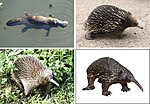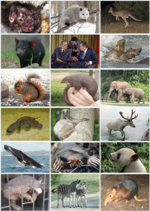 | The evolution of mammals has passed through many stages since the first appearance of their synapsid ancestors in the Pennsylvanian sub-period of the... 141 KB (15,252 words) - 16:07, 26 April 2024 |
 | Monotreme (redirect from Evolution of monotremes) Monotremes (/ˈmɒnətriːmz/) are mammals of the order Monotremata. They are the only known group of living mammals that lay eggs, rather than bearing live... 43 KB (4,277 words) - 20:56, 10 May 2024 |
 | Ungulate (redirect from Evolution of ungulates) "Condylarths: Archaic hoofed mammals" in Paleocene mammals of the world Savage, RJG, & Long, MR (1986). Mammal Evolution: an illustrated guide. New York:... 59 KB (5,852 words) - 16:06, 25 April 2024 |
 | Marsupial (redirect from Evolution of marsupials) palate of marsupials contains more openings compared to placental mammals. Teeth in marsupials also differ significantly from those in placental mammals. For... 73 KB (7,589 words) - 15:35, 11 May 2024 |
 | as well. Mammals portal Cetaceans portal Evolutionary biology portal Paleontology portal Aquatic adaptation Evolution of mammals Evolution of sirenians... 81 KB (9,674 words) - 05:09, 5 May 2024 |
prostate evolution in monotreme mammals. Testicular descent occurs to a variable degree in various mammals, ranging from virtually no change of position... 6 KB (751 words) - 23:14, 19 December 2023 |
 | Nocturnal bottleneck (category Evolution of mammals) physiology, and most mammals are still nocturnal. Mammals evolved from cynodonts, a group of superficially dog-like synapsids in the wake of the Permian–Triassic... 10 KB (1,054 words) - 09:07, 2 April 2024 |
 | Marine mammals are mammals that rely on marine (saltwater) ecosystems for their existence. They include animals such as cetaceans (whales, dolphins and... 126 KB (13,329 words) - 22:09, 10 May 2024 |
 | Theria (redirect from Therian mammals) (thēríon) 'wild beast') is a subclass of mammals amongst the Theriiformes. Theria includes the eutherians (including the placental mammals) and the metatherians (including... 11 KB (932 words) - 23:44, 5 May 2024 |
 | of similar placental and marsupial forms is described by Richard Dawkins in The Blind Watchmaker as a case of convergent evolution, because mammals on... 56 KB (5,672 words) - 11:21, 19 April 2024 |
 | Feliformia (redirect from Evolution of feliform mammals) Handbook of the Mammals of the World, Volume 1: Carnivora. Barcelona: Lynx Ediciones. pp. 50–658. ISBN 978-84-96553-49-1. Barycka, E. (2007). "Evolution and... 22 KB (2,185 words) - 07:15, 5 April 2024 |
 | Polyphyodont (section Evolution in mammals) elephants and kangaroos are unusual among mammals because they are polyphyodonts, in contrast to most other mammals which replace their teeth only once in... 7 KB (784 words) - 17:58, 4 December 2023 |
Semelparity and iteroparity (redirect from Evolution of semelparity) The evolution for semelparity in both sexes has occurred many times in plants, invertebrates, and fish. It is rare in mammals because mammals have obligate... 37 KB (4,489 words) - 23:51, 13 May 2024 |
 | clade composing of a major group of eupelycosaurian synapsids that includes mammals and their ancestors and close relatives. Many of the traits today... 28 KB (2,725 words) - 21:31, 11 May 2024 |
(1984). The evolution of mammalian characters. Croom Helm. ISBN 0-7099-1534-9. Kemp T.S. 2005. The origin and evolution of mammals. Oxford University Press... 11 KB (1,396 words) - 19:41, 2 August 2022 |
 | Eupelycosauria (redirect from Stem mammal) fossils of Echinerpeton and perhaps an even earlier genus, Protoclepsydrops, representing just one of the many stages in the evolution of mammals, in contrast... 10 KB (775 words) - 14:59, 11 May 2024 |
The monotremes (egg laying mammals) represent the order of extant mammals most distantly related to humans. The platypus (Ornithorhynchus anatinus) is... 8 KB (907 words) - 14:01, 16 April 2024 |
 | Pelycosaur (redirect from Mammal-like reptiles) Sphenacodontidae Order Therapsida Evolution of mammals List of pelycosaurs Vertebrate paleontology Cope, E. D. (1878). "Descriptions of extinct Batrachia and Reptilia... 12 KB (1,185 words) - 15:48, 24 March 2024 |
Macroevolution (redirect from Macro-evolution) change. For instance, the evolution of mammal diversity in the past 100 million years has not required any major innovation. All of this diversity can be... 32 KB (3,516 words) - 00:47, 30 April 2024 |
 | Limbic system (redirect from Evolution of the limbic system) of the limbic system leads to a recognition that its presence "represents the history of the evolution of mammals and their distinctive family way of... 38 KB (4,740 words) - 15:07, 1 April 2024 |
 | Synapsida (redirect from Proto-mammals) "mammal-like reptiles" is incorrect under the new definition of "reptile", so they are now referred to as stem mammals, and sometimes as proto-mammals... 55 KB (5,615 words) - 04:25, 24 April 2024 |
T. S. Kemp (category Fellows of St John's College, Oxford) on the evolution of mammals, and particularly for identifying the criteria by which proto-mammals (synapsids) should be classified as mammals. He is an... 2 KB (238 words) - 19:59, 13 April 2023 |
 | Gestation (category Reproduction in mammals) develops within the parent). It is typical for mammals, but also occurs for some non-mammals. Mammals during pregnancy can have one or more gestations... 14 KB (1,509 words) - 14:57, 23 February 2024 |
 | Caniformia (redirect from Evolution of caniform mammals) group of semiaquatic marine mammals which is closely related to an extinct group of pinnipeds, Enaliarctos. While support for the monophyly of pinnipeds... 21 KB (1,976 words) - 20:13, 24 March 2024 |






